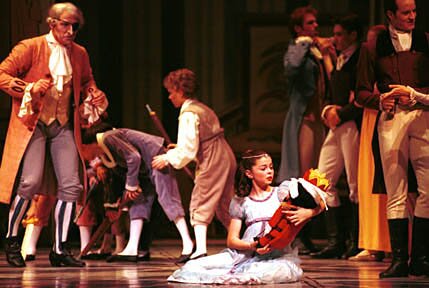 Pacific Northwest Ballet School student in "The Nutcracker" (Photo: © Angela Sterling)
Pacific Northwest Ballet School student in "The Nutcracker" (Photo: © Angela Sterling)
If you've been following The Nutcracker Chronicles, Alastair Macaulay's blog in the New York Times about his cross-country Nutracker-a-thon, you know that while the basics of the story remain largely the same from production to production, many ballet companies--large and small--employ artistic license to contextualize their Nutcracker for a local audience.
In the Nashville Ballet's production, young Clara goes to the 1897 Tennessee Centennial Exposition and her dreams take her to the land of sweets. In San Francisco, National Jewish Theatre Festival presented The MeshugaNutcracker! with the traditional Tchaikovsky music played in a klezmer style. The Tucson Regional Ballet's version is set in Tucson in the 1880's and features a battle between the coyotes and the U.S. Calvary.
With this in mind, I was wondering at last Friday night's performance what the Stowell/Sendak Nutcracker says about Seattle. I'd argue that it's: "Sure, we like our land of sweets, but it shouldn't be all fun and games, ya know." Maybe it's our Scandinavian heritage....
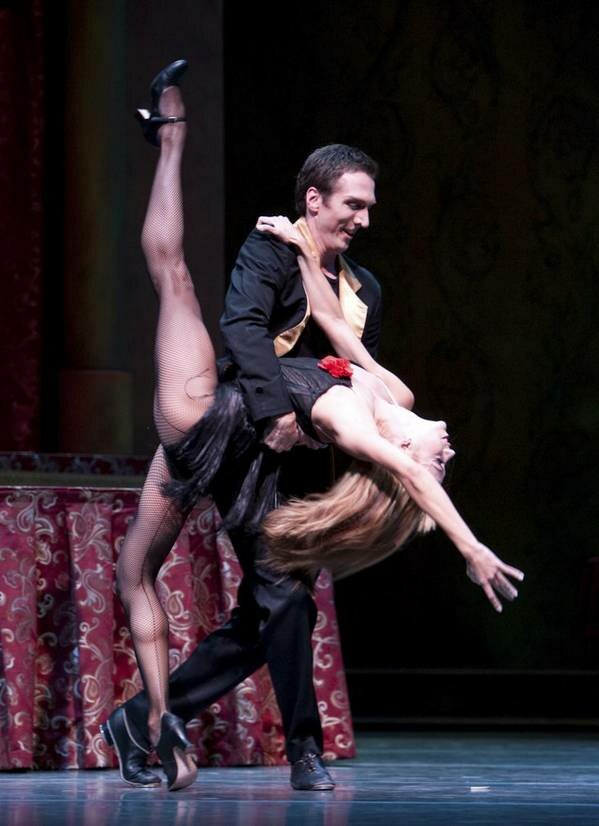 Pacific Northwest Ballet principal dancers Lesley Rausch and Jeffrey Stanton in George Balanchine's Slaughter on Tenth Avenue (Photo: ©Angela Sterling)
Pacific Northwest Ballet principal dancers Lesley Rausch and Jeffrey Stanton in George Balanchine's Slaughter on Tenth Avenue (Photo: ©Angela Sterling)
Pacific Northwest Ballet has just sent out a news release announcing that principal Jeffrey Stanton will retire after the 2010-11 season. He will have danced with PNB for 17 years, after coming to Seattle from San Francisco Ballet.
"I can now retire from my professional ballet career knowing that I gave it everything I had," says Stanton. Peter Boal remembers in particular one performance that Stanton did just that: "Jeff is perhaps the best hoofer I have ever seen in Slaughter on Tenth Avenue. During one of his triumphant performances in this role he suffered a severe sprain of his ankle. Sitting in the audience, I never knew. Jeff continued to dance with all of the charm and swagger that the role required. Audiences would never have guessed that Jeff left the theater that night in a wheelchair."
Read the full release after the jump:...
Last Wednesday, Paul Taylor's Taylor 2 Dance Company visited Bellevue's Theatre at Meydenbauer Center with a three-piece evening. Established in 1993 by now-80-year-old choreographer and dance giant Paul Taylor, Taylor 2 is a touring group that travels all over the world.
His dances are often reworked for this six-person troupe, allowing for Taylor 2 to play in smaller houses with smaller budgets. The six-member company of young dancers is to Paul Taylor's main company as the Seattle Opera Young Artists Program is the Opera's mainstage performances. With this performance, you don't get technical precision, but you do get a youthful spirit of dancers emerging as artists.
The evening started (oddly, ten minutes early) with 3 Epitaphs. First performed in 1956, the piece begins as slouching figures lope onto the stage, covered head-to-toe in dark grey jumpsuits designed by the American abstract expressionist artist Robert Rauschenberg. With small mirrors over their eyes and on the palms of their hands, their knuckle-dragging treatise on posture--and playful sense of humor--brought to mind designer sock monkeys. (All right, they also reminded me of the back-up dancers for the Black Eyed Peas, circa "Boom Boom Pow.")
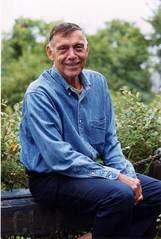 Paul Taylor (Photo: Maxine Hicks)
Paul Taylor (Photo: Maxine Hicks)
Taylor's focus on everyday movements, and their integration into his choreography, was revolutionary at the time--and so commonplace in dance today that it's hard for us now to see this piece as those who saw its premiere did. The lazy jazz music--an early form played, interestingly, at both weddings and funerals in NoLa--matches the intentionally lazy body movements of the dancers.
Taylor's brilliance was more in evidence in Duet from Roses. This balletic pas de deux featured dancers Justin Kahan and Madelyn Ho. Much of this piece is a pretty, standard duet from any story ballet. Even the music, Adagio for Clarinet and Strings by Heinrich Baermann, is reminiscent of Tchaikovsky's Nutcracker, making me wonder where the Taylor was in all of this.
But if you look closely, you see the small touches that are, for me, what makes his work a departure from Ballanchine. At one point, Kahan crouches down and places his hands, one above the other, gently on Ho's right hip. It's a tiny detail, lasting for only a few seconds and serving no purpose other than to convey an intimacy in a way deeper than your standard ballet vocabulary allows. Both danced with a graceful fluidity. Ho, whose bio mentions her recent graduation with a degree in Chemical and Physical Biology from Harvard, is charismatic. While some of the other dancers are clearly more accomplished, she has a magnetic quality that outshines them.
The last piece, Company B, subtly juxtaposes the innocence that was represented in the pop culture in the '40s with the realities faced by soldiers at the time. It begins quietly, with the full company emerging from a grayish fog-like light, as if they are stepping in from the past. The Andrews Sisters kick in with "Bei Mir Bist du Schön" and all are in high spirits. During the "Pennsylvania Polka," a couple whirls about the stage, while upstage, two soldiers act out war games in slow mo. In "The Boogie Woogie Bugle Boy (of Company B)," Kahan is all brash exuberance until he's shot in the last moment of the piece. If you blink you miss it--and you see the piece completely differently.
Having seen Taylor's work performed by ballet companies across the country--especially Company B--I can say that Taylor 2's performance lacks the cohesiveness that, say, a PNB would bring to Taylor's choreography. But Taylor interpreted by a ballet company is a different animal. Beautiful, but different. Taylor 2 brings a non-classical, everyday movement feel to the work that works. It's different, imperfect, and beautiful.
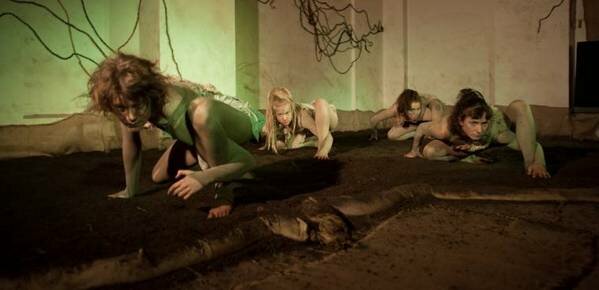 Manifold Motion's Under at INScape Arts. Photo by Chris Hunt.
Manifold Motion's Under at INScape Arts. Photo by Chris Hunt.
"We are working with the inspiration of lichens, fungi, mosses, and molds," Keely Isaak Meehan told me recently in a telephone interview. "That whole world of small organisms that creep into the undergrowth of the forest and unused man-made spaces."
Inanimate objects may not seem like the logical inspiration for a choreographer, but honestly, that's one of the things I find so fascinating about Manifold Motion, the company run by Meehan and her husband Mike McCracken, who does interactive technology and design, in conjunction with a variety of long-time collaborators. Part dance company, part installation and interactive technology artists, Manifold Motion presents ambitious, complex performances in which movement artists interact with immersive worlds generated in cross-disciplinary collaboration to produce works that one way or another are going to surprise. Just this last weekend, their new evening-length work, Under, opened at INScape Arts, in the old INS building in the International District, where it runs through November 28, three days a week (tickets $18).
Nearly two years ago, I caught Manifold Motion's last full-length show, Woolgatherer, at the Youngstown Cultural Arts Center, and as it began, I was a little bored: Bridget Gunning came onstage and performed a sort of psycho-emotional breakdown in dance-form against a screeching electronic score, in front of a digitally generated projection. Oh God, I thought, here's another exploration of the stresses of modern life crushing someone's soul. But about as soon as I thought I couldn't take it anymore, Gunning collapsed, tearing down the projection screen with her and exposing a stunningly realized anti-modern world constructed of distressed wool yarn....
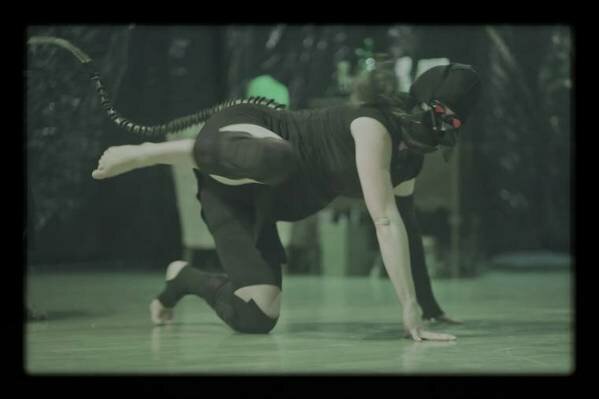 PB_TMOG's "Ayudapii: The Primitive (The Evolution of Need: Phase 1)". Photo by Tim Summers
PB_TMOG's "Ayudapii: The Primitive (The Evolution of Need: Phase 1)". Photo by Tim Summers
I didn't have a long wait at all, it turns out. PB_TMOG's Ayudapii: The Primitive (The Evolution of Need: Phase 1) (previewed here; Nov. 12-14 at Open Flight Studio, tickets $14) is definitely not your haunted house. Aside from having nothing to do with Halloween, the music is live, the designs are professional and the tone of the evening is the opposite of kitsch. This is your haunted house's older brother's smart college friend. It just might be the most unique performance I've seen all year. If you're the kind of person who's excited by things that are experimental and a little bit risky, you should probably buy tickets now, because seating is limited and there are only three performances left....
 Pacific Northwest Ballet principal dancers Karel Cruz and Carla Körbes in Twyla Tharp’s Waterbaby Bagatelles, presented as part of ALL THARP, Nov. 5-14, 2010. Photo © Angela Sterling
Pacific Northwest Ballet principal dancers Karel Cruz and Carla Körbes in Twyla Tharp’s Waterbaby Bagatelles, presented as part of ALL THARP, Nov. 5-14, 2010. Photo © Angela Sterling
"Cruz lifts Körbes, and then she pivots on his hands, as if about to launch herself forward into the water, and you desperately wish you could rewind that again and again," is what I wrote in my review of PNB's "All Tharp" over the weekend. So PNB's Gary Tucker did the next best thing, and sent five photos of the moment along. Click on the photo to be able to choose a larger version, but either way take a moment to let the inventiveness of Tharp's choreography embed itself in your brain. I don't know that there are any studies proving you'll be more creative as a result, but it can't hurt.
An evening with Twyla Tharp is worth making plans for, even if it's a vicarious accompaniment, through the medium of her dance works.
The three pieces on Pacific Northwest Ballet's "All Tharp" program (ends November 14) this time are Opus 111, Afternoon Ball, and Waterbaby Bagatelles, and it feels a bit like dinner date that begins with a walk through an autumn forest declaiming Keats, includes dinner at a dangerously chic nightspot with a window-view of the street, and ends with flipping through candid snaps of an Olympics swim team clowning and flirting in between meets.
Depending on which night you go, there's a special treat for PNB fans, given her impending departure at the end of the season, to see Ariana Lallone in one or more pieces.
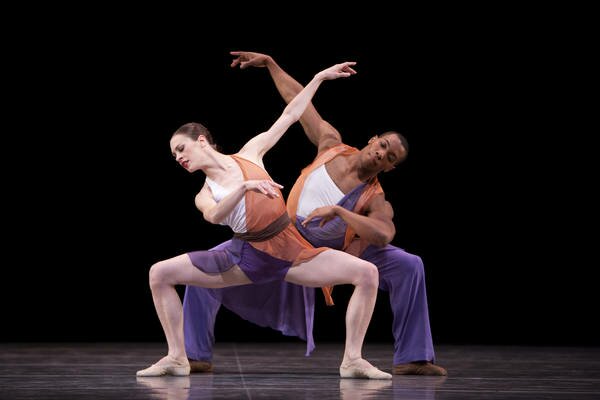 Pacific Northwest Ballet soloist Rachel Foster and corps de ballet dancer Kiyon Gaines in Twyla Tharp’s Opus 111, presented as part of ALL THARP, Nov. 5-14, 2010. Photo © Angela Sterling
Pacific Northwest Ballet soloist Rachel Foster and corps de ballet dancer Kiyon Gaines in Twyla Tharp’s Opus 111, presented as part of ALL THARP, Nov. 5-14, 2010. Photo © Angela Sterling
Brahms' String Quintet underpins Opus 111, and PNB gives you a live quintet (two violins, two violas, and cello) to enjoy. It's four movements, and you see five couples--everyone has their favorites, I'm sure, but for me the kinetic Batkhurel Bold and Carla Körbes stood out, along with a smoldering Ariana Lallone and Karel Cruz--though Tharp's mind seems equally focused on the overall picture: sides of the stage mirror each others' moves, or a movement series ripples its way through a diagonal line. I always wonder how much when you see a dance affects what you see, but something about Mark Zappone's costumes, fluttering swaths of color, made me think of the unpredictable way leaves twirl, coming down. And in any event, the dancers pirouette and spin throughout the piece, their arms almost always in motion, shoulders shrugging or pointing. They're frequently raised in a rounded "V" that near the end, when a more heel-and-toe folk-dance style arrives, becomes that fuller goblet shape you know from Russian dances, a pronouncement of hale-and-heartiness you can't help but be warmed by....
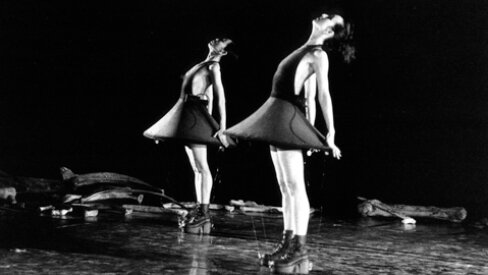 Scene from Pat Graney's "Tattoo" (Photo: Tim Summers)
Scene from Pat Graney's "Tattoo" (Photo: Tim Summers)
The first thing to mention is that if you don't already have your tickets, Pat Graney's Faith Triptych (at On the Boards tonight and Sunday) is sold out. You might call the box office and see if there are returns, if you're desperate. For those of you with tickets, a word of warning: The show starts at 7:30 p.m. and as I exited the time was 11:45 p.m., so there goes your evening.
It's a monumental evening in just about every aspect, from the years-in-the-making works from 1991, 1995, and 2001; to the manipulation of time and space; to the ways women see themselves (or not), and feel embodied. There's spectacle in stagecraft (Jeff Gerson's sand- and rice-falls, and transforming table; Ellen Fullman's sound skirts, pictured above; and a large alligator comfortable enough to sleep on designed by Carla Wesson and built by Marilyn Lysohir) and in concept (the "living Caravaggios" of Faith, the full body art of Tattoo).
It's an enviable position to be in as a choreographer, I suppose, that people walk out discussing which of your major works they like most. Michael Upchurch calls Faith the "best part"; Marcie Sillman explains where the frisson arises: "Slowly, the women lower a body from a cross and carry it tenderly across the stage. For many Christians the ritual is familiar, but the female celebrants are not." Graney spreads the composition across the whole stage, sometimes in magical tableaux that "resolve" suddenly out of languid gesture, sometimes in time, as a body is carried a few steps, then shifted to another woman's shoulders, carried a few steps, and the burden given away again.
An arresting segment with red balls reminded me tangentially of Atalanta and the golden apples. It's the combination of gymnastic athleticism and the interference of the balls, which at times roll across the stage in the reverse direction the dancers run. The dancers catch and balance on them with a certain pride, though there's also a moment when, held between their ankles, the balls act as anchors....
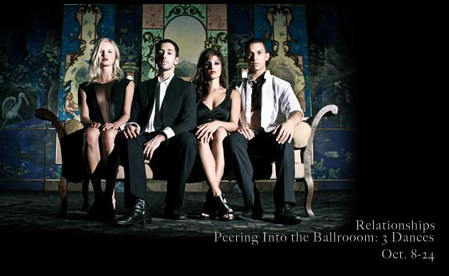 Two couples bent their heads and whispered; one of the men jabbed his finger at the cover of Spectrum Dance Theater's program, showing four dancers in sexy disarray on a bench, and said with mock-indignation, "That's false advertising."
Two couples bent their heads and whispered; one of the men jabbed his finger at the cover of Spectrum Dance Theater's program, showing four dancers in sexy disarray on a bench, and said with mock-indignation, "That's false advertising."
Walking into Spectrum's fall studio series (through October 24, one more weekend left!) expecting dances about "relationships" to be fun and flirtatious will lead to a severe correction.
It's not exactly date-night fare--the most disturbing work on the program, La Valse, takes place in a color- and oxytocin-deprived world. To Mio Morales' electronic "clouds" of sound, four women in cross-front gray dresses that expose glimpses of black bras and four men in gray shirts and black pants glare at each other across the room, Tory Peil looking like a modern-day Valkyrie. (Costumes are by Kasia Walicka Maimone.) The women stride over to feel the men up, slapping asses and hefting pecs; then the men return the favor, giving breasts a squeeze, inspecting teeth.
Choreographer Donald Byrd underscores here not just the process of assessment that comes with sexual relationship, but the indignity of it, and the liveliness of the resentment at being judged and chosen or passed over.
When the dancers take up waltz positions, they confront each other with them, as if this is a karate pose. Instead taking in graceful swoops and coy looks, you watch as the two groups chase each other around the space, in a circle, halting when one or more dancers slip and fall, which serves only to increase the sense of animosity. There are aggressive slaps to the outside of the thigh, there's a sort of barefoot stomp, each adding to a sense of menace....
“duets+,” an evening of dynamic new narrative modern dance, will show at Capitol Hill’s Erickson Theatre, October 22nd and 23rd at 8 p.m. and October 24th at 3 p.m. Sapience Dance Collective’s Dancer/Choreographers Amy Weaver, Lilah Steece, Ariella Brown, Victoria Jacobs, and Sarah Mercer produce their second season, filled with inventive movement, tremendous characterizations, and in-depth collaboration. Tickets are $15-$18 and can be bought in advance at brownpapertickets.com.
“duets+” is a unique artistic group collaboration, as all five members of Sapience have worked closely together to choreograph, produce and perform a surprising range of work. The show opens with a 45-minute suite of five duets by the choreographers. Each chapter’s movement unfolds in a distinctive take on the possible wide-ranging and evolving relationships between two people. The second half features the premiere of "Species," a fully collaborative elaborate new production that explores the conflict and beauty of the urban jungle. Taking on complex human, animal and elemental characters, each performer is transformed by the discord, harmony and irony that exist within our city. “Species” features sound score by Nathan Churchill-Seder.
Founded in 2009, Sapience Dance Collective is a Seattle community-based dance company that features the work of Ariella Brown, Victoria Jacobs, Sarah Mercer, Lilah Steece and Amy Weaver. All company members are choreographers, dancers, and co-directors. Sapience choreographs innovative, physically adept, and socially conscious new works focused on artistic growth and group collaboration.
Sapience Dance Collective is an Associated Program of Shunpike. Shunpike is a 501(c)(3) non-profit art service organization whose mission is to strengthen the Seattle arts community by partnering with small and mid-size arts groups to develop the business tools they need to succeed. Working in close partnership with these groups, Shunpike helps solve problems quickly and impart vital skills in finance, organizational management and arts administration.
For more information, please visit www.sapiencedance.org.
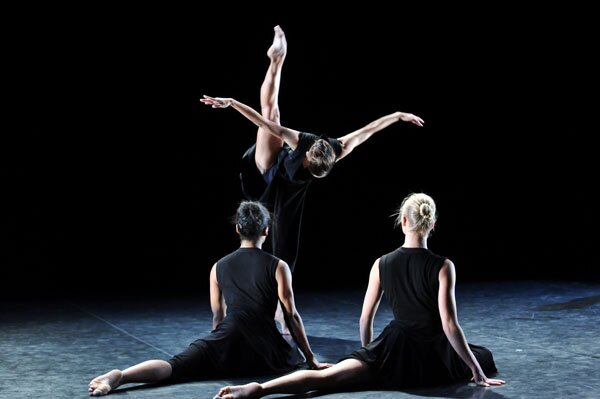 Spectrum Dance Theater company dancers Amber Mayberry, Kylie Lewallen and Tory Peil in Donald Byrd’s Sentimental Cannibalism. Photo by Gabriel Bienczycki, Zebra Visual
Spectrum Dance Theater company dancers Amber Mayberry, Kylie Lewallen and Tory Peil in Donald Byrd’s Sentimental Cannibalism. Photo by Gabriel Bienczycki, Zebra Visual
"Men are not gentle, friendly creatures wishing for love, who simply defend themselves if attacked," Freud admonishes us in his Civilization and Its Discontents. That sentence is quoted in a primer that you get with your program for Spectrum Dance Theater's Fall Studio Series (previewed here). Two more weekends remain, but the first program is over.
If you haven't seen SDT before, they're the Delta Force of modern dance, at least in terms of the hyperkinetic nature of the movement you see; they do more dancing in the first piece on a program than most companies do all week. Ty Alexander Cheng in particular looks to be in shape for an Ironman competition. (The drawback is that some seasons it feels like they could vie with the Seahawks for members on and off injured reserve.) But artistic director Donald Byrd demands more of his dancers than that fearless athleticism.
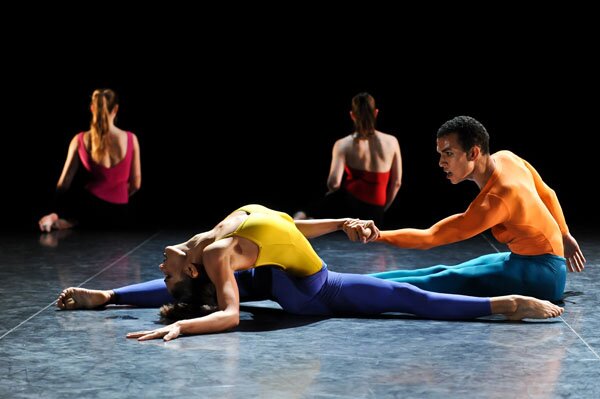 Spectrum Dance Theater company dancers Kylie Lewallen and Ty Alexander Cheng in Donald Byrd’s Soap Box. Photo by Gabriel Bienczycki, Zebra Visual
Spectrum Dance Theater company dancers Kylie Lewallen and Ty Alexander Cheng in Donald Byrd’s Soap Box. Photo by Gabriel Bienczycki, Zebra Visual
They also research and help originate or develop their roles in works. For the revision of a 2006 work, Soapbox, a three-dancer research team explored the birth of the First Amendment, its elaborations and ratification, which is why, in addition to the formation of a square in which groups of dancers make their "arguments" or in which the ensemble dissolves into an organized chaos, a lone dancer stands at the front, reading off drafts of the First Amendment. Audience members are invited to hop up on the box as well, and they say things you'd expect members of a Seattle dance audience to say. I vote for selecting incendiary passages from local blogs' comments sections--today's soap box of choice--and reading those aloud....
A brief editorial: Partly because of the moment, this eighth festival of "Against the Grain / Men in Dance" feels freighted with a particular import. At a time when viewers have watched (over 500,000 times) Dan and Terry tell gay teens that "It gets better," the frustrating impetus behind the existence of Men in Dance--that "society seldom looks kindly on men who dance"--is still very much with us.
To focus on bringing bullying to heel is long-awaited, necessary work, but to watch a Men in Dance program is to be reminded that life promises more than not feeling threatened. It can promise the recurrent delight at finding a safe space that cultivates growth, a creative joy and resulting artistic accomplishments.
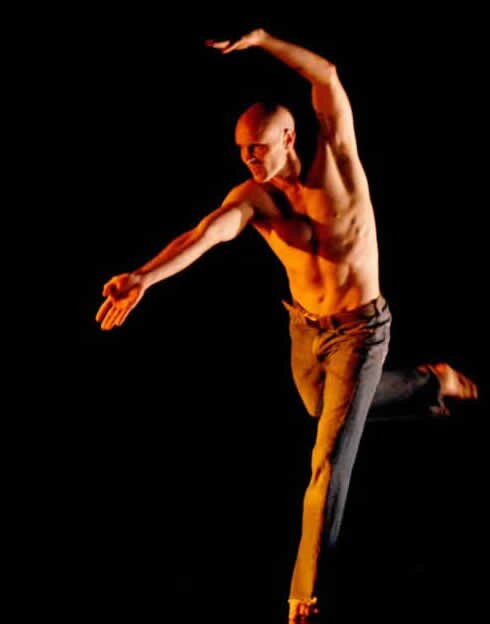 Choreographer Jason Ohlberg (Photo: Colleen Dishy)
Choreographer Jason Ohlberg (Photo: Colleen Dishy)
Week 1 begins with Alia Swersky's "Small Spaces" an anarchic, improvisational claiming of space (in small quantities), with dancers tucking themselves under the stage, doing headers into seatback cushions, and otherwise upping the competitive ante, which is a tone it shares with "Cypher" by Barry Kerollis, a "jam session" of dance that features Josh Spell, Price Suddarth, and Ezra Thomson bringing their moves. But you can't skip over the tap spectacle of "15 to 20," with high schoolers (I think) Christopher Crosby, Jesse Katz, and Evan Pengra-Sult exhibiting just the kind of insouciant flash that makes an audience grin and feel giddy.
What drew me was the chance to see PNB's Peter Boal perform; he's the solo dancer in the premiere of Donald Byrd's "Carveresque." It's a short piece to a Prokofiev sonata for violin and piano, and Byrd turns it into a portrait of a man being danced by music. Boal is a study in nuance, in sneakers and jeans, and I wish I had more space and time to wax philosophic about the piece. It doesn't specifically refer to this, but it reminded me of how dance's presence in the body is resistant even to dementia.
I was also looking forward to seeing Olivier Wevers' excerpt from his triptych "Monster"--this one specifically in response to the bullying and harassment that young gay men don't always survive. Lucien Postlewaite and Andrew Bartee give Wevers' choreography a bracingly fluid, muscular drive. It opens with light and shadow and a one-hand-on-face, one-arm-pointing gesture that reminds me of Invasion of the Body Snatchers, a sign of how relationship is distorted and burdened by prejudice....
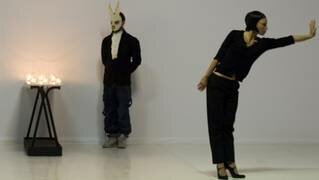 Christian Rizzo's b.c, janvier 1545, fontainebleau
Christian Rizzo's b.c, janvier 1545, fontainebleau
A friend of mine who gave lectures for a living once joked that he was destined to be known as "witty" and "hour-long." I don't know why I thought of that, but I was free-associating a lot last night. I find myself agreeing with Claudia La Rocco's review in the New York Times, when it comes to Christian Rizzo's b.c, janvier 1545, fontainebleau (at On the Boards through Sunday, tickets $25).
Too soon this precision seems precious and fussy. Gerome Nox’s industrial, menacing score howls Sturm und Drang, and the audience waits, in suspense, for action that never takes place. Finally all of the objects have been put away, even Ms. Guibert. It seems they were only props.
I didn't hate the piece; I was so bereft of reaction that (this never happens) I didn't even clap. The woman next to me clapped enough for us both, her arms above her head. A couple, on the way out, looked at each other, and one said to the other in response to the unspoken question: "I liked some parts, I didn't like some parts."
For a more detailed description of the work itself, I can direct you to Jeremy's preview article and Rizzo interview, here on The SunBreak. I'd just add that Julie Guibert's living statue performance is at times mesmerizing, but so much so that it chafes against Rizzo's project of downplaying the danced performance. This he diligently works at with choreography that is generally slow and deliberate, with repetition of a few movement phrases (I'm pleased to find someone else was impressed by The Scorpion!), so that they become genuinely familiar in the course of just an hour.
And while the work begins in silence--you can hear Rizzo's rosary-esque beads clacking as he moves about the stage in his Donnie Darko rabbit mask--Gerome Nox's score is played for about two-thirds of the show at a notch below ear-splitting....
Of the many gifts that choreographer and SDT artistic director Donald Byrd can be said to possess, the one that charms me most off-stage is his inquiry-fueled motormouth. Dancers (and ex-dancers) as a rule are not the most loquacious people to begin with, but Byrd stands out all the more for his insistent, in-public theorizing. Reading his blog over at Spectrum's site is a bit like nipping 'round to Roland Barthes for a chat.
There's not much time left for blog reading in advance of this weekend's first installment of the Fall Studio Series--Drastic Cuts: Duet, Sentimental Cannibalism, Soap Box, and Conte Fantastique--but in advance of next weekend's studio series at SDT, "Peering into the Ballroom" (October 15 to 24), Byrd is busily interrogating (his word) his earlier works that uncritically used the proscenium aesthetic as a frame.
When he presents La Valse, Act 2 from Bristle (1993), Longing (2005), and Le Bal Noir (2006), he wants to:
...draw attention to what is most obvious about these works: they are meant to be seen from a front, there is one ideal vantage point, the images fit within conventional stage pictures, the viewer’s attention is clearly focused (with the things that are most important taking place center-center), and there are no decisions to be made about what is to be watched....
(more)
"I remember that we were doing the rehearsal for the piece I was doing for the Lyon Opera Ballet," choreographer Christian Rizzo told me, chuckling as he recalled one of the first times he met dancer Julie Guibert, in 2004, "and I was really, at this moment, I was happy because it was the first time I was invited to an institution like that, so I was going very little by little, and I was saying to some people, just walk, stop, go on the floor, very quick. And I remember that each time she was doing something--Julie--just walking, hopping, just sitting on the floor, I had the feeling each time she was doing something, it was the right thing, it had the right movement. Everything was right. And I remember one time, she was asking to me, 'But at this moment I'm just walking, what do I have to do?' and I'm saying, 'Just keep going!'"
This was last week, and Rizzo and I were sitting in the third floor business office of the Kitchen, the venerable Chelsea performance space and gallery, where Rizzo's third presentation in the U.S., b.c, janvier 1545, fontainebleau, was going up for three performances in New York City before heading for Seattle, where it opens On the Boards' 2010-11 season this Thursday (through Sun., tickets $25). On the Boards was actually the first institution to present Rizzo's work in the U.S., in 2006, two years before he finally made it to New York, so this marks a sort of U.S. homecoming of sorts.
With b.c, janvier 1545, fontainebleau, Rizzo--who has, in addition to dancing and choreographing, been a rock musician, fashion designer, visual artist, and now filmmaker and opera director--breaks new creative ground. Originally commissioned by the Montpellier Dance Festival and debuted in 2007, b.c, was the first solo Rizzo set for another dancer, the aforementioned Guibert, who has previously performed in work by everyone from William Forsythe to Russell Maliphant.
"I'm more impressed sometimes with people when they start to talk, and you see the knowledge and the intelligence and the language and the reference," Rizzo continued on about Guibert. "And that was for me the first time I'd seen the intelligence everywhere," he began plucking the muscle in his arm, "not connected with the language, but with the flesh. The understanding of everything around her."...
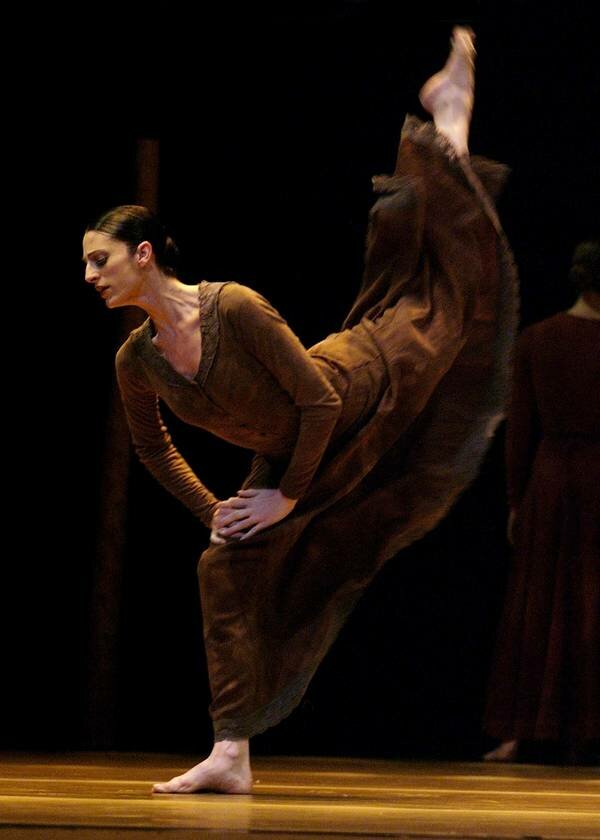 Pacific Northwest Ballet principal dancer Ariana Lallone in Nacho Duato’s Jardí Tancat, presented as part of DIRECTOR’S CHOICE (Photo © Angela Sterling).
Pacific Northwest Ballet principal dancer Ariana Lallone in Nacho Duato’s Jardí Tancat, presented as part of DIRECTOR’S CHOICE (Photo © Angela Sterling).
For over two decades, anyone who's seen more than two Pacific Northwest Ballet performances has learned to look forward to the moment that the phenomenal Ariana Lallone takes the stage. This season those moments will be priceless, as Lallone has announced the 2010-11 season will be her last with PNB. The full news release, with a list of her leading roles, after the jump.
Seattle, WA – Pacific Northwest Ballet Artistic Director Peter Boal and Chairman of the Board Aya Hamilton have announced that principal dancer Ariana Lallone will be leaving the company at the end of the 2010-2011 season, following a 24-year career with PNB. The announcement was made during this evening’s Board of Trustees meeting. ...
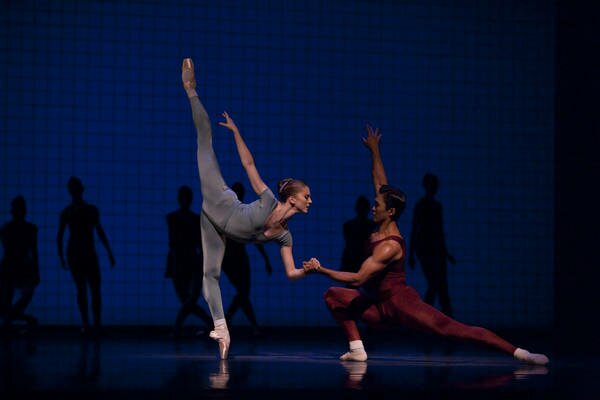 Pacific Northwest Ballet principal dancers Carla Körbes and Batkhurel Bold in Jerome Robbins’ Glass Pieces, presented as part of DIRECTOR’S CHOICE, Sept. 24 – Oct. 3, 2010. Photo © Angela Sterling
Pacific Northwest Ballet principal dancers Carla Körbes and Batkhurel Bold in Jerome Robbins’ Glass Pieces, presented as part of DIRECTOR’S CHOICE, Sept. 24 – Oct. 3, 2010. Photo © Angela Sterling
PNB's Director's Choice program has one more weekend to enthrall dance--not simply ballet--fans. Running through October 3 at McCaw Hall, it's post-Balanchine, but just barely: Three of the four pieces are from the mid-1980s.
My favorite of the evening was the finale, Glass Pieces, an against-type Jerome Robbins work that PNB's Peter Boal is personally acquainted with. Using a Philip Glass score, Robbins looks into the beehive of humanity. "Robbins wanted us to be frenzied pedestrians traversing Grand Central Terminal at rush hour," reports Boal in the program notes. The towering back wall is a gridwork that also suggest the ubiquitous tile of public spaces.
After the first movement's commute--threaded by three spare, elegant duets--a shadowed line of dancers processes slowly across the back of the stage, carrying the rhythm in their hips and knees, trading places, stepping sideways, as Glass's minimalist score also chugs its way past the fevered fingers of the orchestra.
In the second movement, Carla Körbes and Batkhurel Bold have a duet is almost purely musical shapes. It's minimalist dance--for a moment, they stand, arms lightly curving. There's a solidity and amplitude to Körbes and Bold, as if they'd been sculpted from living rock. For the third "act," Robbins has social machinery transmit the movements that gradually lead to a stage-filling ensemble, the initial regimentation blazing out in a furious complexity....
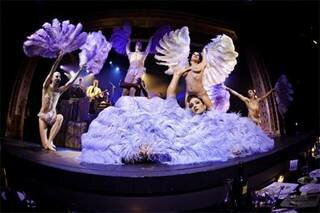 "Where Righteous Rock meets Busby Berkeley and Benny Hill," goes the House of The UnHoly tagline (runs Sept. 23-25, early/late shows at the Triple Door). It's an epic burlesque production, with thirteen dancers, three singers, and five musicians, produced by the Swedish Housewife.
"Where Righteous Rock meets Busby Berkeley and Benny Hill," goes the House of The UnHoly tagline (runs Sept. 23-25, early/late shows at the Triple Door). It's an epic burlesque production, with thirteen dancers, three singers, and five musicians, produced by the Swedish Housewife.
And let me stop you there because surely you know by now whether or not burlesque is of interest. The burlesque I've seen at the Triple Door has always been edgy, untamed, and top-drawer (WINK), but for god's sake, we've come to a pretty pass when I have to spell out what's titillating about burlesque. (OOPS JUST DID!)
I will add that if you haven't seen Waxie Moon perform before, you may be subject to one of those weird laughing/crying jags that end in the hiccups so be ready for that. "This show doesn't resemble a typical burlesque show. It's much much dirtier," Mr/s. Moon told the Examiner....
Hello!
Twitter: @thesunbreak | Facebook
iPhone app download (Free!)
Subscribe to The SunBreak
Delivery Options
![]() Subscribe to all SunBreak Stories
Subscribe to all SunBreak Stories
Daily Email Digest of The SunBreak
Most Viewed Stories
Latest Headlines
Recently in Our Flickr Photo Pool
www.flickr.com
|
Our Facebook Fan Page
Neighborhood Blog News
Niche Blog News
Seattle Weather
Get the SunBreak iPhone App

Download the SunBreak iPhone app for free.
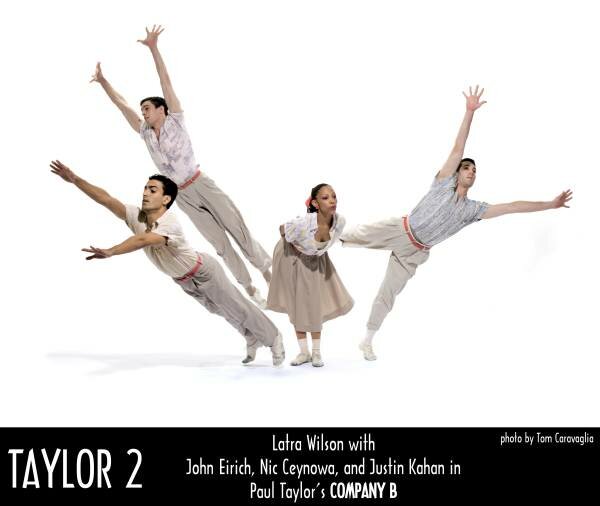
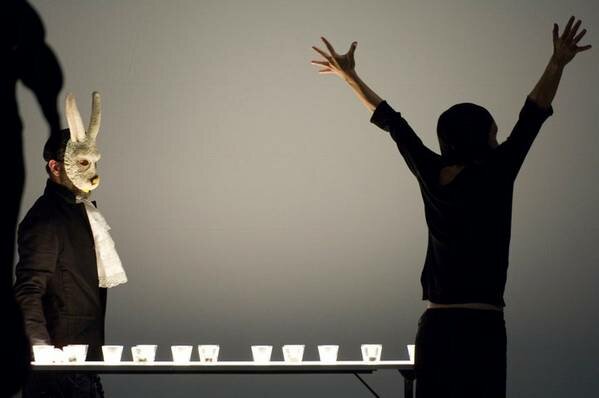


Most Recent Comments